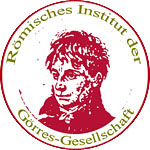New Museum of the Papal Basilica Santa Maria Maggiore
A few days before the start of the Holy Year 2025, a new museum tour was opened in the papal basilica of Santa Maria Maggiore. The Polo Museale Liberiano, under the direction of Dr Andreas Raub, consultant for art history at the RIGG, has thus undergone an impressive expansion and renewal.
In addition to the archaeological excavation site under the basilica, the historical treasury with probably the most important collection of liturgical paraments from the 16th and 17th centuries in Rome, the museum area has also been extended to include the area in the piano nobile of the canonical palace of Pope Paul V (1605-1621).
Visitors can now independently view the large façade mosaic by Filippo Rusuti, dating from around 1295, on the Baroque loggia, which depicts the miraculous snowfall of 5 August, the first depiction of snow in the history of art.
From the loggia, the tour leads into the monumental chapter house. Featuring numerous high-quality portraits of cardinals and popes from the 17th century, this is the entrance to a panoramic corridor to the domes of the Sistine and Pauline Chapel, which offers a fantastic view of the historic centre all the way to St Peter's Basilica. From the Chapter House you can also access the new museum halls, which were inaugurated on 11 December by Cardinal Secretary of State Pietro Parolin.
These are decorated with historical frescoes and are now open to the public for the first time. Thanks to a modern lighting and climate control system, the works of art, some of which were previously exhibited in the basement, are in the best possible conservation conditions.
The first room, entitled Bethlehem of the West, presents Santa Maria Maggiore as a Christmas basilica. The absolute masterpiece is the cot by Arnolfo di Cambio, which was created in 1291 under the Franciscan Pope Nicholas IV (1288-1292) and is considered to be the first of its kind. The marble sculptures, which can now be viewed up close and all around, are in dialogue with a rare example of a liturgical vestment from the 13th century, the so-called ‘Chasuble of St. Jerome’.
Traditionally, as can be read on the object text written in English and Italian, the textile is attributed to the church father. His relics were transferred from Bethlehem to Santa Maria Maggiore at the time of the creation of Arnolfo's nativity figures. It is possible that Jerome already had a special relationship with the first church of St Mary in Rome during his lifetime.
The second room is dedicated to the snow miracle of 5 August. The ceiling fresco by the Bolognese artist Baldassare Croce depicts this poetic founding narrative of Santa Maria Maggiore and is in dialogue with the altarpiece by the Florentine Jacopo Zucchi with the same theme. The painting was painted for the basilica around 1580 and has returned there after more than 270 years, having last been exhibited in the Vatican Pinacoteca.
The most magnificent room is dedicated to the Salus Populi Romani, the most important icon of the Virgin Mary in Rome, which has played a central role in the religious life of the Eternal City for many centuries. The presentation revives the original Baroque staging of the icon of the Virgin Mary, which existed until 1931 and was protected for over three hundred years by a solid metal frame and a silver ornamental plate.
protected by a silver decorative plate. The latter was also used to hold the precious jewellery and crowns that popes such as Gregory XVI (1831-1846) and Pius XII (1939-1958) donated to the Salus.
Jacopo Zucchi's panel painting depicting the procession of Gregory the Great, which has also returned to the basilica from the Vatican Pinacoteca, illustrates the historical significance of the icon of the Virgin Mary for the popes. It extends from Gregory the Great to the pontificate of Pope Francis, who designated the basilica as his final resting place because of his devotion to the icon.
- Details
- Written by: Stefan Heid
- Category: Roman notes
 Römisches Institut der Görres-Gesellschaft
Römisches Institut der Görres-Gesellschaft







